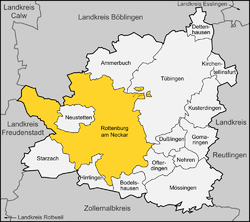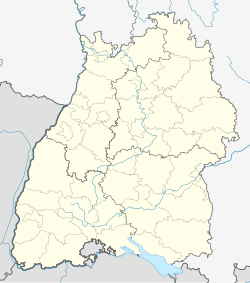Rottenburg am Neckar
Rottenburg am Neckar | |
|---|---|
 The market square in Rottenburg am Neckar | |
| Coordinates: 48°28′38″N 08°56′04″E / 48.47722°N 8.93444°E | |
| Country | Germany |
| State | Baden-Württemberg |
| Admin. region | Tübingen |
| District | Tübingen |
| Government | |
| • Lord mayor (2024–32) | Stephan Neher[1] |
| Area | |
| • Total | 142.26 km2 (54.93 sq mi) |
| Elevation | 349 m (1,145 ft) |
| Population (2022-12-31)[2] | |
| • Total | 44,653 |
| • Density | 310/km2 (810/sq mi) |
| Time zone | UTC+01:00 (CET) |
| • Summer (DST) | UTC+02:00 (CEST) |
| Postal codes | 72101–72108 |
| Dialling codes | 07472, 07478, 07457, 07073 |
| Vehicle registration | TÜ |
| Website | www |
Rottenburg am Neckar is a town in Tübingen in Baden-Württemberg in Germany. It is about 50 km (31 mi) southwest of the state capital Stuttgart and about 12 km (7.5 mi) southwest of Tübingen. Rottenburg is the second-largest town in the district, after Tübingen. Since 1 May 1972, Rottenburg am Neckar has been a district town (Große Kreisstadt). It is the seat of the Roman Catholic Diocese of Rottenburg-Stuttgart.
Rottenburg was founded as a Roman town called Sumelocenna, around the year 98, and was one of the most important Roman towns in the southwest of Germany.
Districts
Rottenburg is divided into a core town and 17 districts:
- Bad Niedernau
- Baisingen
- Bieringen
- Dettingen
- Eckenweiler
- Ergenzingen
- Frommenhausen
- Hailfingen
- Hemmendorf
- Kiebingen
- Obernau
- Oberndorf
- Schwalldorf
- Seebronn
- Weiler
- Wendelsheim
- Wurmlingen
References
- ↑ Oberbürgermeisterwahl Rottenburg am Neckar 2024, Staatsanzeiger. Retrieved 12 June 2024.
- ↑ "Bevölkerung nach Nationalität und Geschlecht am 31. Dezember 2022" [Population by nationality and sex as of December 31, 2022] (CSV) (in German). Statistisches Landesamt Baden-Württemberg. June 2023.
Other websites
Wikimedia Commons has media related to Rottenburg am Neckar.
- Official website (in German)




